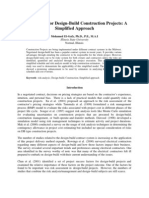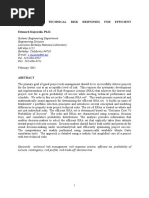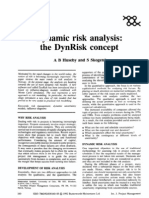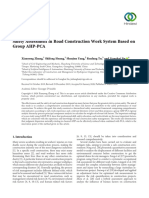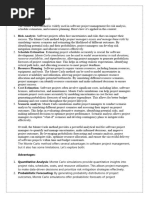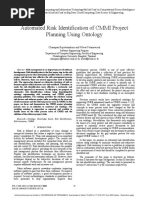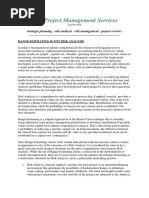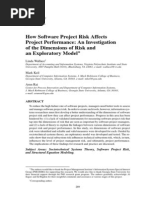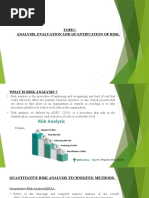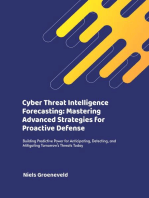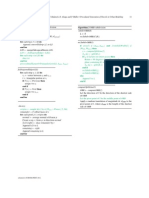Project Risk Simulation Methods - A Comparative Analysis: Abstract. Effective Risk Management
Project Risk Simulation Methods - A Comparative Analysis: Abstract. Effective Risk Management
Uploaded by
Simon WerCopyright:
Available Formats
Project Risk Simulation Methods - A Comparative Analysis: Abstract. Effective Risk Management
Project Risk Simulation Methods - A Comparative Analysis: Abstract. Effective Risk Management
Uploaded by
Simon WerOriginal Title
Copyright
Available Formats
Share this document
Did you find this document useful?
Is this content inappropriate?
Copyright:
Available Formats
Project Risk Simulation Methods - A Comparative Analysis: Abstract. Effective Risk Management
Project Risk Simulation Methods - A Comparative Analysis: Abstract. Effective Risk Management
Uploaded by
Simon WerCopyright:
Available Formats
Abstract.
Effective risk management
provides a solid basis for decisionmaking in projects, bringing
important benefits. While the
financial and economical crisis is
present at the global level and the
competition in the market is more and
more aggressive, the interest in
project risk management increases.
The paper presents a comparative
analysis of the effectiveness of two
quantitative risk analysis methods,
Monte Carlo simulation and the
Three Scenario approach. Two
experiments are designed based on
real projects, in order to compare the
effectiveness of these methods. The
conclusions of the comparative
analysis are that Three Scenario
approach, even if is not as accurate
as Monte Carlo, assures the results
stability, if the same shape of the
probability distribution curve is
considered. The Three Scenario
approach is easy to be applied in
practice and requires a shorter
computation time than Monte Carlo.
Keywords: project risk management,
Monte Carlo, Three Scenario
approach, simulation.
PROJECT RISK SIMULATION
METHODS A COMPARATIVE
ANALYSIS
Constana-Nicoleta BODEA
Academy of Economic Studies, Bucharest
6 Roman Square, 1st district, Bucharest,
Romania
e-mail: bodea@ase.ro
Augustin PURNU
Technical University of Civil Engineering
124 Lacul Tei Blvd., Bucharest, Romania
e-mail: purnus@utcb.ro
Management & Marketing
Challenges for the Knowledge Society
(2012) Vol. 7, No. 4, pp. 565-580
Management & Marketing
1. Introduction
While the financial and economical crisis is present at the global level and the
competition in the market is more and more aggressive, the interest in risk
management increases (Hulett, 2009; Kendrick, 2003; Pritchard, 2011). Effective risk
management provides a solid basis for decision-making in projects, bringing important
benefits, such as: reduced costs, increased engagement with stakeholders and better
change management (Bayati, Gharabaghi and Ebrahimi, 2011). Different project risks
management approaches were defined in standards and guidelines such as:
ICB v3.0, International Competence Baseline, International Project
Management Association (IPMA, 2006);
AS/NZS 4360, Risk Management, Standards Australia/Standards New
Zealand (AS/NZS, 2004);
ISO 21500, Guidance on Project Management, STD v2, International
Organization for Standardization (ISO, 2012);
PMBOK Guide, Guide to the Project Management Body of Knowledge
(PMI, 2008);
SDPM, Success Driven Project Management, Spider Project Team
(Liberzon and Lobanov, 2000).
The project management standards and guidelines recommend similar
frameworks for project risk management. What it is really relevant for differentiating
between risk management approaches is not the process structure as such, but how the
integration of the risk management with all other project management processes is
reinforced. Chapman and Ward (2002) identify a lot of limitations and errors arising
when the risks are managed in projects, even if the project manager has considerable
experience in managing risks. The principal shortcomings relived by Chapman and
Ward are the following: the initial activities for managing risks are too detailed and
fails to underlay the connections with different projects elements in a balanced
manner; the risk identification fails to provide a good structure of the sources of
uncertainty, and to identify significant linkages and interdependences between issues;
the risk estimates are highly dependent on the project scope hypothesis and not on
other kind of assumptions; the risk estimations are costly, but not cost-effective; the
risk evaluation fails to combine properly different source of uncertainty because
crucial dependences are not captured and a weak implementation of the project plan.
The majority of these limitations are linked to the integration of the risk management
processes with each other and with the project management processes in large.
What it is considered by many professionals as being critical for an effective
risk management in projects it is the risk assessment (Bayati, Gharabaghi and
Ebrahimi, 2011; Makait, 2011; Andersen, 2011). If we accept that risk management is
all about identifying, measuring and minimizing uncertain events effecting projects,
then the secret for a good risk management lies in the ability to quality and quantify
the risk elements. This is why these professionals consider the qualitative and
quantitative project risk analysis as the core processes in risk management.
566
Project risk simulation methods a comparative analysis
The project quantitative risk analysis is considered as the hardest part of the
risk management, because it is based on advanced statistics and mathematics methods.
A lot of deterministic and probabilistic methods were developed over time and made
available, especially through software implementation. But these methods are usually
not properly applied, or not applied at all. The main reasons for this are lake of
expertise, difficulties in collecting historical data, complexity of risk quantification
methods and also the computation effort. Only for a few project types, such as:
research and development projects and public and military capital Investments in
projects, the risk quantification is regularly performed.
In the absence of easy to use tools and techniques for project risk
quantification, most of the project team applies exclusively risk qualitative analysis. A
study conducted by the Chartered Institute of Building between December 2007 and
January 2008 highlights the fact that despite the development of sophisticated tools
and techniques, a large number of construction projects are delayed and over budget
and because the project quantitative risk analysis is missing (CIOB, 2008). The more
complex the projects are, the less likely it is to achieve the success.
2. Project quantitative risk analysis methods
The experience gained in a large number of projects reveals the fact that using
only deterministic methods of scheduling leads to a low probability of success. For this
reason project scheduling and monitoring must always include techniques for risk
simulation in order to obtain feasible results. Simulation is increasingly applied in
business. As a project management method, simulation depends on two essential
elements: a model for defining the project outcomes and outcome values and a
technique that repeatedly generates scenarios (Schyler, 2001). Variables whose values
are not known with certainty, but can be described by probability distributions are
called stochastic variables.
In the simulation, in order to emulate the variability of such variables is
necessary to generate possible values based on its distribution probability. The
information about probabilities is necessary both for building the simulation model and
for analyzing the simulation results. To construct the probability distribution of a
variable we can apply the following procedure:
Collect data on values of the stochastic variable;
Group values into intervals and develop the histogram of the relative
frequencies;
Analyze of the relative frequency histogram graph to determine whether a
shape resembling theoretical distributions known. The probability distribution type
can be appreciated using correlation tests, such as: Kolmogorov, Smirnov, Pearson (or
2), measuring the closeness between the theoretical and probabilistic distribution of
values obtained from historical data or expert estimations. Finally, the distribution
parameters are calculated.
The risk simulation methods can be semi-probabilistic and probabilistic ones.
PERT (Program Evaluation and Review Technique), originally developed in the late
567
Management & Marketing
50s is one of the first project planning approach addressing the project risks. PERT
takes into consideration the uncertainties using the three points estimation method.
Basing on their experience and the historical information the project team estimates
for each activity three durations: optimistic, pessimistic and most probable. The
probability to meet a project target date (time or cost) is computed considering only
the activities on the critical path. Different results in terms of accuracy may be
obtained if we use different probability distribution curves. It may be used Beta,
Normal or Triangular probability distribution. The critics of PERT are based mainly
on the hypothesis included in the method, which leads to errors in results, which are
considered optimistic in comparison with other methods.
By the 1960s, Monte Carlo simulation is embedded in PERT, in order to avoid
assuming that only one path may be critical and that the probability distribution of the
project duration must be normal. In the same time, GERT (Graphical Evaluation and
Review Technique) is defined, based on the decision trees embedded in Markov
processes. GERT enhances the project managers ability to understand how the project
is affected by the corrective actions, considered as repetitive processes, executed in a
specific timeframe window. In 1970s, Chapman developed SCERT (Synergistic
Contingency Planning and Review Technique) approach, based on the fault tree and
event tree concepts, for safety analysis (Chapman and Ward, 2003).
The next two paragraphs will shortly introduce Monte Carlo simulation and
three-scenario approach. In the final part of the paper, we will compare the
effectiveness of these two methods, by means of two experiments designed and ran by
the authors.
3. Monte Carlo simulation
Recognized by the accuracy of its results, Monte Carlo method is part of the
probabilistic methods used in risk simulation. The Monte Carlo method first generates
artificial variable values, using a random number generator uniformly distributed in
the interval [0, 1] and the associated cumulative distribution function. Then, the Monte
Carlo method uses the obtained results to extract values from the probability
distribution that describes the behavior of the stochastic variable.
3.1. Monte Carlo simulation with discrete stochastic variable
For discrete stochastic variables, the list of possible values and the
corresponding probabilities form a discrete probability distribution. In the terminology
of probability theory, one can note the stochastic variable as X, xi being a particular
value of the variable X. The probability that the value of a variable X equals to xi is
denoted as P(X = xi) = P(xi). The probability that the value of variable X exceeds a
certain value xi is called the cumulative distribution function and it is denoted as F (xi).
The most common theoretical discrete probability distributions are the discrete
uniform distribution, the binomial distribution and the Poisson distribution.
568
Project risk simulation methods a comparative analysis
The discrete uniform distribution describes variables with a small number of
possible values, each with the same probability of realization. If the number of
possible values is n, and set values possible is {x1, x2 xn}, then the probability mass
function is P(X = xi) = P(xi) = 1/n for any value xi, and the cumulative distribution
function is F(xi) = P(X xi) = i/n, for i = 1, 2, ...,n.
The binomial distribution is a discrete probability distribution that applies
when there are only two possible outcomes: success or failure, admitted or rejected,
passed or not passed, etc. For example, the stochastic variable is the number of
experiments with "success". If p, the probability of "success" is the same for each of
the n experiments, and experiments are independent, the probability mass function is
defined by the probability that the number of successful experiments to be equal to a
and
can
be
calculated
with
the
expression:
value
xi
P( X = xi ) = P( xi ) = Cnxi p xi (1 p) n xi , for xi = 0, 1, , n, where n is the number of
experiments.
The
cumulative
distribution
function
is
defined
as:
xi
F ( xi ) = P ( X xi ) = P (v) , for xi = 0, 1, , n. The average, has the value n*p,
v =0
and the dispersion is define as: 2 = np(1 p) .
The Poisson distribution is a discrete probability distribution that applies to
independent random events. The stochastic variable is the number of events that can
occur in a period of time. The probability mass function is the probability that the
number of events occurring within a specified time to a value equal to xi and can be
xi e
, where is the average
calculated with the expression: P ( X = xi ) = P ( xi ) =
xi !
number of events in a time specified.
Procedure for applying the Monte Carlo method with stochastic discrete
variables
The following procedure can be applied when stochastic discrete variables are
included in the simulation model:
Step 1. Calculate the probability P (X = xi) = P (xi) and cumulative distribution
function: F ( x i ) = P ( X x i ) =
xi
P ( v ) , for xi {x1, x2,, xm}.
v=0
Step 2. The random number intervals are associated to each value of to variable
discrete. This can be graphic or tabular.
Step 3. Generate a random number u uniformly distributed in the interval [0, 1]
using a random number generator.
Step 4. Calculate xi, the value of discrete stochastic variable. This can be done
graphic or tabular. Graphically, function F(xi) has a specific shape on x0y
coordinate. We can set the y value (the probability) and we can found the
stochastic variable value on x coordinate.
Steps 1-4 is being repeated until a predetermined number of trials are
completed.
569
Management & Marketing
3.2. Monte Carlo simulation with continue stochastic variable
Unlike discrete probability distribution, it is not possible to define a
continuous probability distribution in order to determine the probability for some
particular value of continue stochastic variable. Since a continuous stochastic variable
is a variable that can have any value a specified period, it has an infinite number of
possible values in that interval and thus the probability that a continuous stochastic
variable to have some particular value is zero. For a continuous stochastic variable, it
is possible to defined probability as the variable value to be included in a specified
interval. In this regards, the distribution is represented by a curve, and the probability
is determined by evaluating the area under the curve between the interval margins on
x-axis. Function f(x) which calculates the area is called by probability density and
shall meet some conditions. In some cases the probability density function is quite
difficult to calculate, but there are tables of values or software programs for
continuous theoretical distributions, such as: continuous uniform distribution,
triangular distribution, normal distribution, beta distribution and exponential
distribution.
The continuous uniform distribution. If a stochastic variable uniformly
distributed in [a, b], the probability density, f(x) is defined as follow: f (x) = 0 for x <
a, f (x) = 1/(b a) for a x b and f (x) = 0 for x > b. The cumulative distribution
function, F is defined as follow: F(x) = 0 for x < a, F(x) = (x a)/(b a) for a x b,
and F(x) = 1, for x > b. Media, is equals with (a + b)/2 and variance 2 is equals
with (b-a) 2/12.
The triangular distribution. It describes the probability values of a variable by
three values: the minimum (a), the most likely (b) and maximum (c). It is assumed that
the probability of achieving the minimum and maximum value is zero. The probability
density function, f(x) is f(x) = 2 (x-a)/((b a) (c a)), for x b and f(x) = 2(c x)/
((c a)(c b)) for b < x c. The cumulative distribution function, F(x) is define as
follow: F(x) = P(X x) = 0, for x < a, F(x) = ((x-a)2)/((b a)(c a)), for a x b,
F(x) = 1 ((c x)2)/((c a)(c b)), for b < x c, F(x) = 1, for x >c. Mean is equals
with (a + b + c)/3, and dispersion, 2 is equals with (a2 + b2 + c2 a*b a*c b*c)/18.
The normal distribution (Gaussian distribution). It describes the population
characteristics or distributions of quantities that are sums of other sizes (according to
the central limit theorem). Thus, the total duration of a project, the amount of
probabilistic duration of activities on the critical path is a variable with normal
distribution. Normal distribution is a symmetrical distribution as a bell. Function f (x)
is a probability density function with two parameters, mean, and dispersion 2,
( x ) 2 . Since f(x), the probability density
1
having the form: f ( x ) =
exp
2
function of the normal distribution cannot be integrated exactly, it is not used directly.
Calculation of areas needed to determine the probabilities P(a x b) and the
570
Project risk simulation methods a comparative analysis
cumulative distribution function are based on the standard normal probability
distribution, which is a normal distribution of a stochastic variable with mean = 0,
dispersion 2 = 1 and standard deviation = 1. To transform a stochastic variable X
with normal distribution into a stochastic variable Z with the standard normal
distribution, the following formula can be used: Z = (x )/. In the standard normal
distribution tables, there are probabilities P(0 Z z), which represents the value of
the area under the curve of probability density function f(z) located between the
average value, = 0 and z.
The Beta distribution. It has many shapes, by adjusting the following two
parameters: a scaling coefficient, and an offset. A beta distribution can range from a
symmetric, normal distribution to asymmetric one, with a long tail on the positive
side. The exponential distribution; It is used to describe the time between events. It
can be shown that if the number of arrivals can be described by a Poisson distribution,
the interval between arrivals follows an exponential distribution.
4. Three Scenario approach
A semi-probabilistic approach which simulates not only the uncertainties but
also the risk events is the Three Scenario approach (Liberzon, 1996). The risk events
are selected and grouped using the regular approaches in qualitative risk analysis. The
application of this method requires first of all the development of the risk response
plan. This highlights the uncertainties in duration and cost estimation together with the
risk events for which are established action measures affecting both the project
duration and cost. There are obtained three estimations (optimistic, most probable and
pessimistic) for all initial project data (duration, volume of work, productivity,
calendars, resources) which will be used in rebuilding the probability curves for dates,
costs and material requirement. Though it doesnt have the accuracy as comparison
with the probabilistic methods, the Three Scenario approach is characterized by its
stability in results, and as a consequence, by its precision. Knowing the current
probability to achieve the target dates for each phase of the project allows us to
establish the probability trends. By using management by trends as a tool in decision
making, the probability trend give us a clear imagine about how the project is run and
the way the buffers are consumed during the time.
In practice, the quality of initial data for project risk simulation is never good
enough to apply an accurate method like Monte Carlo simulation. In addition,
collecting, analyzing and processing the initial data require often a lot of time.
Included in the Success Driven Project Management Methodology, the Three Scenario
approach is a semi-probabilistic method for approximation of probability distribution
(Archibald, Liberzon and Souza Mello, 2008) used together with the Management by
Trends. The identified risk events are estimated to reflect their effects taking into
consideration resource usage or productivity rates, work scope or volume, cost
estimates, calendar or weather variation and their consequences are included in the
571
Management & Marketing
risk response plans. As result, there will be developed not one, but three scenarios of
the same project schedule and budgets:
Optimistic Scenario includes the risk events with a probability exceeding
90%;
Most Probable Scenario is based on the most probable estimates and
includes the risk events with a probability exceeding 50%;
Pessimistic Scenario is based on the pessimistic estimates and includes all
selected risks.
Basing on the risk response plans, the most probable and pessimistic
scenarios will include additional activities, work volumes, durations, resources,
productivities, costs, calendars, financing and supply, other than the optimistic
scenario. The calculated scenarios with resource leveling and project budgeting are
used to rebuild the probability curves (for dates, costs, and material requirements)
with a predefined shape of probability curve (Figure 1). Defining the desired target
probabilities will allow us to obtain the desired dates for finishing the project, costs
and material requirements (Liberzon and Archibald, 2003). The project target
probabilities are usually defined by the organization risk tolerance, but for regular
projects, it should be in the range of 65%-75%. The three scenarios will establish the
buffers (for time, costs and materials) which will be available for the project
manager during the execution phase.
Figure 2. Success probability trend
Figure 1. Three scenario approach cumulative probability
The probabilities to meet the target dates are called success probabilities and
they are used to measure the buffer penetration. If the success probability trend is
positive, than the buffer consumption was lower than expected, otherwise the buffer
consumption was higher than expected and are required corrective actions (Figure 2).
That means we will not focus on the activities total floats as it is in the actual approach
of project management, but on how the buffers are consumed during the execution
phase, as result of risk events.
The success probability trends measure and show not only project
performance but also project health taking into consideration both internal and
572
Project risk simulation methods a comparative analysis
external factors. The main advantage of three scenarios approach is that it can be
applied easily in medium and large projects.
Probability Distribution Curve. Having the three scenarios we know the range
of most frequent values for project duration, total cost, material requirements, resources
etc. In order to build the probability distribution curve we rely on the three points with
the probabilities according to the three scenarios: the point with zero probability for the
optimistic scenario, the point with 100 % probability for the pessimistic scenario and the
point for which the probability distribution has the maximum value (Figure 3). What we
dont know is the shape of the probability distribution curve. This can be Beta, Normal
or Triangular. In fact, in the Three Scenario approach method the shape of the
probability distribution curve is not so important. We know from the very beginning that
the results are not accurate so they are not close to the exact value, but successive
measurements will give results very close each other. That means the results are
characterized by precision. During the project execution the same shape of the
probability distribution curve will be used. In this way, even the shape is not the correct
one; we will be able to establish if the probability will become greater or smaller as a
result of risk events or the application of preventive or corrective measures (Liberzon
and Souza Mello, 2011). To exemplify the probability computation for a certain target
date we will use the triangular distribution (Figure 4). The probability to achieve the
target date is represented by the area under the probability distribution curve at the left
side of the target date. P =
s
, where: P is the probability to achieve the target date; s
S
the area between the target date and the probabilistic date and S the total area under the
probability distribution curve.
Figure 3. The probability distribution curve
Figure 4. Triangular distribution
Considering that X is the probability to achieve the target date, O is the
optimistic scenario value, M is the most probable scenario value, P is the pessimistic
scenario value and T is the target date value, the probability to achieve the target date
573
Management & Marketing
will be: X = 1
(P T )2 .
(P O ) ( P M )
Let us consider the following project where the
optimistic duration is 15 days, the most probable duration is 20 days and the
pessimistic duration is 29 days, presented in Figure 5.
Figure 5. Numerical example
If we define the desired target date as being the 23 days duration, the
probability to achieve it based on the triangular distribution curve will be 71.43%.
During the project execution the optimistic, most probable and pessimistic scenarios
durations will change. For each update stage we will compute the current probability
to achieve the target date, in our example, 23 days. The results of optimistic, most
probable and pessimistic scenarios duration and the current probability to achieve the
target date are presented in Table 1.
Table 1
Duration for optimistic, most probable and pessimistic scenarios and the current
probability to achieve the target date
Optimistic
duration
Most probable
duration
Pessimistic
duration
Target
data
Current
probability
15
20
29
23
71.43%
13.9
15.9
21
23
88.95%
12.25
14.25
20.5
23
87.88%
11.7
13.7
20.5
23
89.56%
11.15
13.15
19.75
23
81.39%
10.6
12.6
19.5
23
80.05%
10.05
12.05
19
23
74.28%
9.5
11.5
18.5
23
67.86%
574
Project risk simulation methods a comparative analysis
The probability trend is presented in the Figure 6.
Figure 6. Probability trend
If the probability trend is positive then no action should be taken. If, on
contrary, the probability trend is negative, then corrective actions are needed. Using
such an approach allows us to identify as soon as possible the manifestation of the risk
events and to take the proper decisions to.
5. A comparative analysis of the Monte Carlo and Three Scenario
approach methods
In our endeavor to compare the results of Monte Carlo and Three Scenario
approach methods we used the same software which has implemented both methods
and has the same specific heuristics for resource constrained scheduling, Spider
Project. It avoid us to obtain not valid results as time as different project management
software use different algorithms for resource constrained scheduling than other
software that has implemented Monte Carlo method (Liberzon, Shavyrina and MakarLimanov, 2012). In order to highlight the advantages of using one or another risk
simulation method, we applied them in two real projects of medium size and we
calculated the probabilities to achieve the target dates (for the finish date and total
cost). The analysis was performed with a computer having a processor of 2.7 GHz
Intel Core I7, with RAM of 4 GB at 1333 MHz DDR3. The probability distribution
curve used in computation was the Beta distribution and the number of iterations for
Monte Carlo method was 1000.
5.1. The first experiment
The first project is the construction of an office building with ground floor and
four stories with a duration estimation of 10 months (Figure 7). The project model
took into consideration only the infrastructure and superstructure works, together with
architectural works.
The required level of detail lead to a project model consisted of 221 activities,
54 different types of resources (manpower and equipments) grouped into 8 resource
centers, and 94 different types of materials grouped into 3 material centers. The
575
Management & Marketing
project costs were modeled using 11 cost components grouped into 5 cost centers.
Three scenarios (optimistic, most probable and pessimistic) were developed taking
into account the identified risk. Different productivities, material consumption,
activity calendars, resource team's structures and costs resulted from the risk response
plan. The target dates were established for project duration and cost as following: the
target duration is 182 days and the target total c is 465.000 Euros.
Figure 7. Office building model
Using both Monte Carlo and Three Scenario approach we obtained the
probabilities to achieve the target dates as shown in Figures 8 and 9.
Figure 8. Probability curves in (a) Monte Carlo and (b) Three Scenario approach for
parameter project duration
Figure 9. Probability curves in (a) Monte Carlo and (b) Three Scenario approach for
parameter project total cost
576
Project risk simulation methods a comparative analysis
Using the Monte Carlo method, the probabilities obtained are higher than the
probabilities obtained using Three Scenario approach. The computation duration is
also much larger than in the Three Scenario approach (Table 2).
Table 2
Probabilities to achieve the target date with Monte Carlo and Three Scenario
approach
Method
Monte Carlo
Three Scenario Approach
Parameter
duration
88.30%
84.90%
Parameter
total cost
99.90%
71.90%
Computation duration
(seconds)
675
3
5.2. The second experiment
The second experiment is based on an oil and gas project, which represents
the periodic maintenance of an installation. The project has 453 activities, 12 different
types of resources (manpower and equipments) grouped into 4 resource centers and 3
cost components grouped in two cost centers. The most probable project duration was
estimated to 13.8 days, using a calendar of 6 days working days (Figure 10).
Figure 10. Oil and gas project model
Taking into account the identified risk events and the risk response plan, it
was decided to establish the probability to achieve the following project data: target
duration: 15.6 days and target total cost: 640.000 Euros. The different activities from
the optimistic, most probable and pessimistic scenario, different productivities,
resources and costs, lead to the following results in Monte Carlo and Three Scenario
Approach methods for the project target dates are shown in Figures 11 and 12.
577
Management & Marketing
Figure 11. Probability curves in (a) Monte Carlo and (b) Three Scenario approach
for parameter project duration
Figure 12. Probability curves in (a) Monte Carlo and (b) Three Scenario approach
for parameter project total cost
Similar to the first project, the probabilities to achieve the target dates are
higher in Monte Carlo method than in Three Scenario approach (Table 3).
Table 3
Probabilities to achieve the target date with Monte Carlo and Three Scenario
approach
Method
Monte Carlo
Three Scenario
Approach
Duration parameter
99.30%
75.30%
Total cost
parameter
99.90%
64.20%
Computation duration
(seconds)
321
3
The reason Three Scenario approach method leads systematically to lower
probabilities than Monte Carlo method is that it allows taking into account the
unknown unknowns which are present in every project. The computation duration in
Monte Carlo method depends on the number of activities, resources, cost components,
calendars, and is bigger as the number of information contained in the project model is
bigger. The Three Scenario approach takes into consideration the same amount of
information, but the algorithm is not iterative and the computation duration is
measured in seconds.
578
Project risk simulation methods a comparative analysis
6. Conclusions
Project risk management represents a significant area in project management.
The authors analyzed several risk management standards and guidelines and
concluded that what it is really relevant for differentiating risk management
approaches is not the process structure as such, but how the integration of risk
management with all other project management processes is reinforced. The authors
focused on risk simulation methods recommended and used in project quantitative risk
analysis, investigating theoretical and in practice two methods, Monte Carlo and the
Three Scenario approach. In order to compare the effectiveness of the methods, two
experiments were designed based on real projects.
Even if the Monte Carlo method is very accurate, its practical application is
not feasible because of the iterations, which require effort and time for computation.
The application of Monte Carlo needs a great amount of time for the preparation of
input data when the projects are of medium and large size, with hundreds and
thousands activities, resources, materials and cost components. As time as the project
environment is in continuous changing the accuracy of the results using Monte Carlo
method does not help the project managers too much in decision making. Though the
Three Scenario approach is a semi-probabilistic method and it is not as accurate as
Monte Carlo, the use of the same shape of the probability distribution curve gives it
stability in results. It is easy to be applied in practice and requires a very short time for
computation. Time and cost buffers are set by defining reliable targets that have
reasonable probabilities to meet.
The application of management by trends of the probability to achieve the
target dates is in fact the management of buffers penetration allows project managers
to identify timely the risk events and to react properly. Trends of probabilities to meet
project targets (success probabilities) are most valuable and integrated project
performance indicators. They depend not only on project performance but also on
project environment.
References
Andersen, D.L. (2011), Project Risk management Inside Out: How to cope with complexity
generated risk, Future Trends in Project, Programme and Portfolio Management,
Proceedings International Expert Seminar, IPMA, Zrich
Archibald, R., Liberzon, V. and de Souza Mello, B.P. (2008), The Application of Success
Probabilities, Success Driven Project Management/SDPM, and Some Critical Chain Concepts
to the Oil & Gas Industry in Brazil, The Annual PMI College of Scheduling Conference,
Chicago
AS/NZS (2004). AS/NZS 4360: Risk Management, Standards Australia/Standards New
Zealand, available at: http://www.ucop.edu/riskmgt/erm/documents/as_stdrds4360_2004.pdf
Bayati, A., Gharabaghi, A.A. and Ebrahimi, M. (2011), Practical risk management in
petrochemical industries: an NPC case study, Future Trends in Project, Programme and
Portfolio Management, Proceedings International Expert Seminar in Zrich, IPMA
579
Management & Marketing
Chapman, C. and Ward, S. (2002), Managing Project Risk and Uncertainty A Constructively
Simple Approach to Decision Making, Chichester: John Wiley & Sons Ltd.
Chapman, C. and Ward, S. (2003), Project Risk Management, Processes, Techniques and
Insights, 2nd edition, John Wiley & Sons Ltd.
CIOB (2008). Managing Risk of Delayed Completion in the 21st Century, Chartered Institute
of Building, pp.52-53
Hulett, D. (2009), Practical Schedule Risk Analysis, Gower
IPMA (2006), IPMA Competence Baseline (ICB 3.0), International Project Management
Association (IPMA)
ISO (2012), Guidance on Project Management, ISO 21500, STD v2, International
Organization for Standardization
Kendrick, T. (2003), Identifying and Managing Project Risk, AMACON
Liberzon, V. (1996), Resource Management and PMBOK, Proceedings of the 27th Annual
PMI 1996 Seminars & Symposium, Boston
Liberzon, V. and Souza Mello, B.P. (2011), Success Driven Project Management (SDPM)
Approach to Project Planning and Performance Analysis, The 8th Annual PMI College of
Scheduling, San Francisco
Liberzon, V., Shavyrina, V. and Makar-Limanov, O. (2012), Advanced Project Scheduling
What is necessary for creating adequate project model and is absent in most scheduling
tools, The 9th Annual PMI College of Scheduling Conference, New York
Liberzon, V. and Archibald, R. (2003), From Russia with Love: Truly Integrated Project Scope,
Schedule, Resource and Risk Information, PMI World Congress, Hague, May 24-26
Liberzon, V. and Lobanov, I. (2000), Advanced Features of Russian Project Management
rd
Software, The 3 PMI Europe Conference Proceedings, Jerusalem, Israel, 12-14 June
Makait, T. (2011), Qualitative and quantitative: EPC Project Risk Management is no gamble,
Future Trends in Project, Programme and Portfolio Management, Proceedings International
Expert Seminar in Zrich, IPMA
PMI (2008), PMBOK Guide: A Guide to the Project Management Body of Knowledge,
Newtown, PA: Project Management Institute
Pritchard, C.L. (2011), Risk Management-Concept and Guidance, 2nd edition, ESI International
Schyler, J. (2001), Risk and Decision Analysis in Projects, 2nd edition, PMI Inc
About the authors
Constana-Nicoleta BODEA is professor at the Academy of Economic Study
Bucharest, Economic Informatics and Cybernetics Department. Currently, she teaches
Artificial Intelligence and Project Management. She coordinated several projects,
achieving experience in managing large research projects consortia. Her research
interests include project management competence modeling using computational
intelligence methods, agent technologies, e-learning systems and data mining.
Augustin PURNU is associate Professor at the Technical University of Civil
Engineering Bucharest, Management in Construction Department, with more than 25
years experience in Construction Project Management. He is involved as consultant
and trainer in the implementation of Project Management System in various
companies in Romania, as well as Project Manager in different projects.
580
You might also like
- Project Risk Management: A Practical Implementation ApproachFrom EverandProject Risk Management: A Practical Implementation ApproachRating: 4 out of 5 stars4/5 (2)
- 42R-08 Risk Analysis and Contingency Determination Using Parametric EstimatingDocument9 pages42R-08 Risk Analysis and Contingency Determination Using Parametric EstimatingDody BdgNo ratings yet
- Schedule Risk Analysis v1Document13 pagesSchedule Risk Analysis v1ita1270% (1)
- 57R-09 Aace PDFDocument24 pages57R-09 Aace PDFmirakulNo ratings yet
- CS 229, Summer 2019 Problem Set #1 SolutionsDocument22 pagesCS 229, Summer 2019 Problem Set #1 SolutionsSasanka Sekhar SahuNo ratings yet
- Book II Section 1Document5 pagesBook II Section 1IanwangNo ratings yet
- Q2 - Physically Unclonable Functions (2018)Document254 pagesQ2 - Physically Unclonable Functions (2018)Nguyễn Văn SángNo ratings yet
- CP GT 118002007Document8 pagesCP GT 118002007Manju Civil PNo ratings yet
- Project Risk Analytic Assessment Using The Hierarchy ProcessDocument7 pagesProject Risk Analytic Assessment Using The Hierarchy ProcessKresna Fajar NegaraNo ratings yet
- Decision Supporting System For Risk Assessment in Construction Projects: AHP-Simulation Based TechniqueDocument15 pagesDecision Supporting System For Risk Assessment in Construction Projects: AHP-Simulation Based TechniqueInternational Journal of Application or Innovation in Engineering & ManagementNo ratings yet
- Risk AnalysisDocument21 pagesRisk AnalysisArmando RodasNo ratings yet
- GULEIDDocument6 pagesGULEIDguleidNo ratings yet
- GULEIDDocument6 pagesGULEIDguleidNo ratings yet
- $Qhzdssurdfkirutxdqwlwdwlyhulvndqdo/Vlv: Faculty of Business and EconomicsDocument27 pages$Qhzdssurdfkirutxdqwlwdwlyhulvndqdo/Vlv: Faculty of Business and EconomicsFernando AcebesNo ratings yet
- Risk Analysis For Design-Build Construction Projects: A Simplified ApproachDocument8 pagesRisk Analysis For Design-Build Construction Projects: A Simplified Approachyan energiaNo ratings yet
- Best Practice Management of Risks in ProjectsDocument32 pagesBest Practice Management of Risks in ProjectsPuneet AroraNo ratings yet
- Risk Analysis & ContengencyDocument8 pagesRisk Analysis & ContengencymanikantanNo ratings yet
- Recent Advances in Risk Analysis and Management (RAM)Document5 pagesRecent Advances in Risk Analysis and Management (RAM)Ijact EditorNo ratings yet
- Selection of Technical Risk Responses For Efficient Contingencies Edouard Kujawski, PH.DDocument26 pagesSelection of Technical Risk Responses For Efficient Contingencies Edouard Kujawski, PH.DJosh SabimanNo ratings yet
- 4-IJCI Vol. 3 No. 3-March 2024-Paper3-Dr. ObaidDocument16 pages4-IJCI Vol. 3 No. 3-March 2024-Paper3-Dr. Obaidالمجلة الدولية للحاسبات والمعلوماتية – EISSN 2976-9361No ratings yet
- Dynamic Risk Analysis: The Dynrisk Concept: InternetDocument5 pagesDynamic Risk Analysis: The Dynrisk Concept: InternetSam BliNo ratings yet
- Development of Multi-Party Risk and Uncertainty Management ProcessDocument262 pagesDevelopment of Multi-Party Risk and Uncertainty Management ProcessRui FerreiraNo ratings yet
- Time Varying Concerns in ProjectsDocument9 pagesTime Varying Concerns in ProjectsLa SadaNo ratings yet
- Sem 0708 PDFDocument11 pagesSem 0708 PDFRitodip BhattacharyaNo ratings yet
- Examining The Value of Monte Carlo Simulation For Project Time ManagementDocument11 pagesExamining The Value of Monte Carlo Simulation For Project Time ManagementRohit MathurNo ratings yet
- Examining The Value of Monte Carlo Simulation For Project Time ManagementDocument11 pagesExamining The Value of Monte Carlo Simulation For Project Time ManagementSteeltonNo ratings yet
- Multi-Criteria Analysis Incorporating Risk Evaluation For Excellent Project SelectionDocument1 pageMulti-Criteria Analysis Incorporating Risk Evaluation For Excellent Project Selectionapi-207179647No ratings yet
- Event Chain Methodology in Project Management: Why Project Managers Ignore Risks in Project SchedulesDocument25 pagesEvent Chain Methodology in Project Management: Why Project Managers Ignore Risks in Project SchedulesMohammad DoomsNo ratings yet
- Research Article: Safety Assessment in Road Construction Work System Based On Group AHP-PCADocument12 pagesResearch Article: Safety Assessment in Road Construction Work System Based On Group AHP-PCAZakky AZNo ratings yet
- B763.content.08955 Risk AnalysisDocument4 pagesB763.content.08955 Risk AnalysisAli SarfarzNo ratings yet
- FMEADocument14 pagesFMEAAndreea FeltAccessoriesNo ratings yet
- Sample - MSC A1 Risk and ProcurementDocument27 pagesSample - MSC A1 Risk and ProcurementmadukafmNo ratings yet
- A Combined AHP-GP Model To Allocate Internal Auditing Time To ProjectsDocument18 pagesA Combined AHP-GP Model To Allocate Internal Auditing Time To ProjectsMarco AraújoNo ratings yet
- Monte Carlo MethodDocument8 pagesMonte Carlo Methodscribd.fever522No ratings yet
- Choosing Project Risk Management Techniques. A Theoretical FrameworkDocument18 pagesChoosing Project Risk Management Techniques. A Theoretical FrameworkAbdul Majet MohamedNo ratings yet
- A Decision Support System For EstimatingDocument9 pagesA Decision Support System For EstimatingijfcstjournalNo ratings yet
- Project Panama Canal FINA-SG v1.0LDocument7 pagesProject Panama Canal FINA-SG v1.0Lsunita@pasNo ratings yet
- 3 PDFDocument6 pages3 PDFIvson SoaresNo ratings yet
- 11.4.1 Perform Quantitative Risk Analysis: InputsDocument6 pages11.4.1 Perform Quantitative Risk Analysis: InputsGyra TyiNo ratings yet
- Cost Estimation Risk TechniquesDocument4 pagesCost Estimation Risk TechniquesV Suriya Raja G SNo ratings yet
- CSC Project Management ServicesDocument10 pagesCSC Project Management ServicesriswanNo ratings yet
- Software Project Risk 6 - 33Document0 pagesSoftware Project Risk 6 - 33Asad MunirNo ratings yet
- Risk Management Is A Systematic Process of IdentifyingDocument8 pagesRisk Management Is A Systematic Process of IdentifyingTATATAHERNo ratings yet
- AKASH CHOWDHURY - SoftwareDocument4 pagesAKASH CHOWDHURY - Softwarepriyanka.debnath.cse.2021No ratings yet
- Perform Quantitative Risk AnalysisDocument12 pagesPerform Quantitative Risk AnalysissdfasdfasdfasfaNo ratings yet
- Methodology - For - Analysis - and - Modelling - Risk - ECRM - 2011 - Vásquez, JDocument5 pagesMethodology - For - Analysis - and - Modelling - Risk - ECRM - 2011 - Vásquez, JIvanNo ratings yet
- Project Planning KhodakeramiDocument25 pagesProject Planning KhodakeramiJogender50% (2)
- 2000-Stochastic Budget SimulationDocument9 pages2000-Stochastic Budget SimulationSmita SangewarNo ratings yet
- RISKDocument13 pagesRISKAshleyNo ratings yet
- J Omega 2014 06 001Document32 pagesJ Omega 2014 06 001jarvisle11No ratings yet
- CIB6212Document12 pagesCIB6212عبدالمعز المليانNo ratings yet
- G10 Research Paper Done V1.8Document16 pagesG10 Research Paper Done V1.8ANKIT GOYALNo ratings yet
- Simple Method Proposal For Cost Estimation From Work Breakdown StructureDocument8 pagesSimple Method Proposal For Cost Estimation From Work Breakdown StructureRizwan IshaqNo ratings yet
- 2024 Kruti MLDocument11 pages2024 Kruti MLGhazali YaidNo ratings yet
- Risk Quantification For New Product Design and Development in A Concurrent Engineering EnvironmentDocument4 pagesRisk Quantification For New Product Design and Development in A Concurrent Engineering Environmentsachin_choudhary_5No ratings yet
- Risk and Procurement Management - MBanica - 1820078Document12 pagesRisk and Procurement Management - MBanica - 1820078Mihai BanicaNo ratings yet
- Unit- 7 Risk Management and Resource Allocation-slides(0)Document23 pagesUnit- 7 Risk Management and Resource Allocation-slides(0)iambipinverma2024No ratings yet
- Risk ManagementDocument17 pagesRisk ManagementRawaz KanabieNo ratings yet
- Mastering Opportunities and Risks in IT Projects: Identifying, anticipating and controlling opportunities and risks: A model for effective management in IT development and operationFrom EverandMastering Opportunities and Risks in IT Projects: Identifying, anticipating and controlling opportunities and risks: A model for effective management in IT development and operationNo ratings yet
- Advanced Stochastic Models in Finance and Economics: FINANCIAL ENGINEERINGFrom EverandAdvanced Stochastic Models in Finance and Economics: FINANCIAL ENGINEERINGNo ratings yet
- The Practice of Lending: A Guide to Credit Analysis and Credit RiskFrom EverandThe Practice of Lending: A Guide to Credit Analysis and Credit RiskNo ratings yet
- Cyber Threat Intelligence Forecasting: Mastering Advanced Strategies for Proactive DefenseFrom EverandCyber Threat Intelligence Forecasting: Mastering Advanced Strategies for Proactive DefenseNo ratings yet
- Procedural Generation of Parcels in Urban Modeling AppendixDocument5 pagesProcedural Generation of Parcels in Urban Modeling AppendixtwakNo ratings yet
- Segmap: Segment-Based Mapping and Localization Using Data-Driven DescriptorsDocument18 pagesSegmap: Segment-Based Mapping and Localization Using Data-Driven Descriptorsxingwu jiNo ratings yet
- Control Theory With MathScript ExamplesDocument87 pagesControl Theory With MathScript ExamplesvelmuruganNo ratings yet
- Chap05 ForecastingDocument61 pagesChap05 Forecastingtaylor swiftyyyNo ratings yet
- Malware Detection Using Machine LearningDocument5 pagesMalware Detection Using Machine LearningInternational Journal of Innovative Science and Research TechnologyNo ratings yet
- WPA2Document6 pagesWPA2James HeathNo ratings yet
- CSI 4107 - Winter 2016 - FinalDocument11 pagesCSI 4107 - Winter 2016 - FinalAmin DhouibNo ratings yet
- CO1508 Computer Systems & Security - Week 03 Cryptography Exercises - Cryptool 1Document7 pagesCO1508 Computer Systems & Security - Week 03 Cryptography Exercises - Cryptool 1Edward LeeNo ratings yet
- Digital Image ProcessingDocument14 pagesDigital Image ProcessingsubhikshaNo ratings yet
- d2l en PDFDocument635 pagesd2l en PDFsasaki_kojiroNo ratings yet
- Back PropagationDocument20 pagesBack PropagationShame BopeNo ratings yet
- A One-Dimensional Steady Conduction Problem: by CTTCDocument2 pagesA One-Dimensional Steady Conduction Problem: by CTTCValentin ValhondoNo ratings yet
- 3 Simplex ProcedureDocument38 pages3 Simplex ProcedureSudhanwa KulkarniNo ratings yet
- String MatchingDocument27 pagesString Matchingprateekrana462No ratings yet
- Instant download Computer vision: theory, algorithms, practicalities Fifth Edition Davies - eBook PDF pdf all chapterDocument39 pagesInstant download Computer vision: theory, algorithms, practicalities Fifth Edition Davies - eBook PDF pdf all chapterayshasandryNo ratings yet
- Phylogenetic Trees (BIOINFORMATICS)Document7 pagesPhylogenetic Trees (BIOINFORMATICS)Aayudh DasNo ratings yet
- Neural Representation of AND, OR, NOT, XOR and XNOR Logic Gates (Perceptron Algorithm)Document14 pagesNeural Representation of AND, OR, NOT, XOR and XNOR Logic Gates (Perceptron Algorithm)MehreenNo ratings yet
- Improving Classification With AdaBoostDocument20 pagesImproving Classification With AdaBoostHawking BearNo ratings yet
- T.Y.B.Sc. It Sem Vi SIC MCQ-Unit-5Document4 pagesT.Y.B.Sc. It Sem Vi SIC MCQ-Unit-5Shiva ChapagainNo ratings yet
- Hashing Algorithm Linked Hash Map - Notes Lyst8155Document10 pagesHashing Algorithm Linked Hash Map - Notes Lyst8155It's MeNo ratings yet
- Lesson 11 - Introduction To Compound Interest - 2019-2020Document8 pagesLesson 11 - Introduction To Compound Interest - 2019-2020kelvinNo ratings yet
- Bitcoin Whitepaper - Satoshi Nakamoto PDFDocument12 pagesBitcoin Whitepaper - Satoshi Nakamoto PDFharsha2085No ratings yet
- Ad3351 Daa Lab ManualDocument53 pagesAd3351 Daa Lab Manualhodcse2018No ratings yet
- Level Control in Horizontal Tank by Fuzzy Controller: Satean and Santi Wangnipparnto2 'DepartmentDocument4 pagesLevel Control in Horizontal Tank by Fuzzy Controller: Satean and Santi Wangnipparnto2 'DepartmentvndhilmechNo ratings yet
- MKTG 470 Regression AssignmentDocument2 pagesMKTG 470 Regression Assignmentsudhir.kochhar3530No ratings yet
- Tangents and NormalsDocument8 pagesTangents and Normalsashton1867No ratings yet
- GATE 2025 Syllabus For Data Science Artificial Intelligence DADocument2 pagesGATE 2025 Syllabus For Data Science Artificial Intelligence DARohit JhaNo ratings yet







